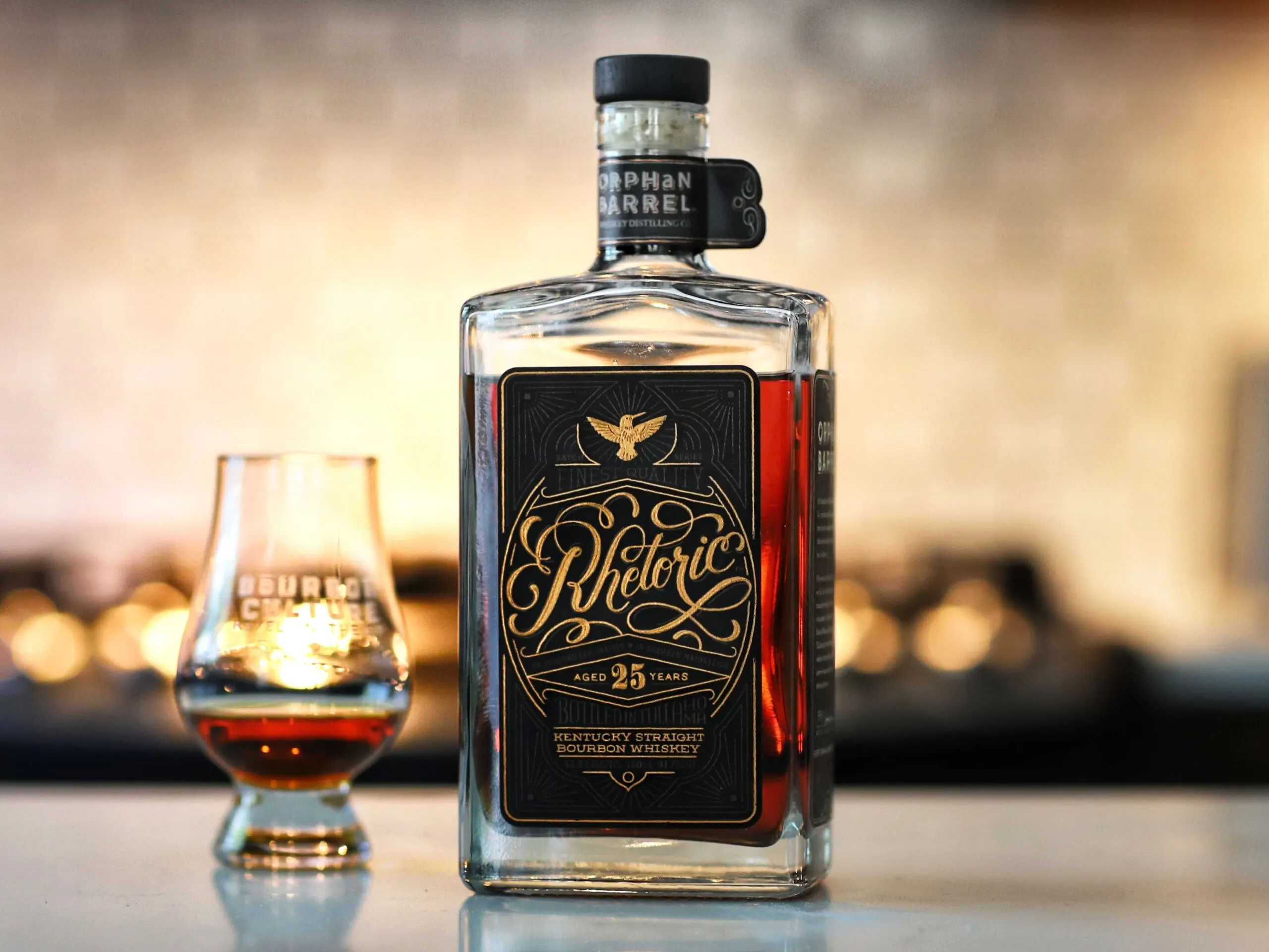| Don't like ads? | No ads |
*Bourbon Culture is reader-supported. When you buy through links on our site, we may earn an affiliate commission.
Orphan Barrel finished with what was perhaps the last release that truly mattered for the brand in mid-2018: Rhetoric 25 Year Old Bourbon. Since then, the Orphan Barrel line has seen mediocre American-sourced whiskey from either Cascade Hollow (Dickel) or MGP.
What made Rhetoric so alluring was that it contained bourbon aged at the Stitzel-Weller campus for over two decades. No, it was not Stitzel-Weller bourbon. The whiskey inside was distilled at the Bernheim Distillery (DSP-KY-1) sometime between 1991 and 1993.
What kind of bourbon is Rhetoric 25?
The vast majority of the barrels that Diageo had inside of the warehouses at Stitzel-Weller Distillery were probably intended for use in I.W. Harper products.
But after Diageo bought the distillery along with its warehouses full of barrels, it no longer had a use for all of them. The mashbill was 86% corn, 6% rye and 8% malted barley.
The low-rye content meant that the bourbon had a tendency to be on the sweeter side with very little spice to it. In a nutshell – it was made to be inoffensive rather than engaging.

This mash bill made up a majority of the bourbon released under the Orphan Barrel line. Its two closest competitors – Barterhouse 20yr and Old Blowhard – all shared the same mash bill. The differences between each primarily lay in how they were blended together.
Diageo needed a way to separate a new bourbon label from those two, so they went to the drawing board to find a new way to market it so that consumers wouldn’t feel duped. What they came up with was a multi-year release showing how bourbon changes as it matures.
Each year, they’d bottle up barrels from the same batch and bottle them up .2 proof points (yes, you read that right) higher than the previous year’s. Rhetoric 20 Year would be bottled at a straight 90 proof while Rhetoric 25 ended up being 91 proof.
The Rhetoric Experiment: More Questions than Answers
Let’s break down the Rhetoric Experiment. Diageo/Orphan Barrel decided to showcase how whiskey would change in a barrel as it aged. Most distilleries do this experiment with barrels from the same lot that are younger – say 3 or 4 years old.
Then they keep releasing them until they’re about 8 or 10 years old (see: Pinhook). This makes sense because those initial years see a lot of change in the barrel. But after 12 years or so, most bourbon will have maxed out on how much they transform. A majority of the time, they struggle to remain drinkable due to the barrel influence that begins to overpower everything.

The blenders and marketers at Orphan Barrel pushed on with this idea regardless of how much it sense it made. In reality, this is probably the best they could come up with because they had no other barrels to do it with aside from these ultra-aged ones.
Their plan eventually took shape in 2014 with the release of Rhetoric 20 Year in 2014 followed by Rhetoric 21 in 2015, Rhetoric 22 in 2016, Rhetoric 23 in 2017 and Rhetoric 24 AND 25 in 2018.
Not only did this experiment start off on a strange note (using 20+ year old bourbon), but there seemed to be no control measure put in place. What I mean by that is that unless they batched the barrels together in the beginning and split them up equally, how would we know what really changed?
We weren’t given any information on if the barrels all had the same distilled-on day or even if they were all aged in the same warehouse + floor. To me, an experiment like this could only make sense if they took all of these 20 year old barrels, batched them together, and redistributed them back into barrels.
In fact, that’s where a certain rumor comes into play that Rhetoric was batched together in the beginning. The only issue is, I can’t find any reviews or press releases that talk about it. But when I ask other like-minded enthusiasts, many tell me they’ve heard the same story of Rhetoric being batched together at the beginning of the experiment.

Otherwise, if Orphan Barrel didn’t establish some sort of control over the barrels early on, then why should we believe the results? What if all Rhetoric 22 year old barrels came from a grouping where the barrel quality was terrible? And what if Rhetoric 24 had barrels that were absolutely amazing? The result would be that consumers would walk away with the opinion that 22 years old is a terrible age for bourbon but somehow they turn immaculate on their 24th birthday.
Rhetoric 25: The Final Chapter In A Strange Experiment
Orphan Barrel got creative with physically distinguishing each Rhetoric release from each other by having the labels get progressively darker with each subsequent bottling. Rhetoric 25 is the darkest label (basically black with raised gold lettering) whereas the 20 year was a light yellow.
As I mentioned before, each Rhetoric received a tiny bump in proof so the 25 year was bottled at 91 proof which was very low but on par with other Orphan Barrel releases.
This low proof should soften a lot of the harsh and bitter tannins while hopefully sweetening things up a bit. But the only way to know that for sure is by actually tasting it. Speaking of which, I think it’s time to get down to the notes. As always, I’m sampling this neat in a glencairn.
Tasting Notes
Nose: For being such an old bourbon, I’m surprised with how much sweetness can be distinguished from the tannins. There is velvety caramel and butterscotch layered with chocolate chip cookies. It manages to reduce the pipe tobacco and seasoned oak notes to a supporting role.
Spice is restrained – which might have a lot to do with how low the rye content is. If anything, I get a tiny hint of cinnamon powder and maybe some nutmeg; but that’s it.
Palate: The oak becomes noticeably more bitter once the liquid hits my tongue. There is an astringent note I am picking up on that doesn’t ruin the experience, but it knocks it down a peg. Notes of chocolate fudge, maple syrup and coconut shell stand out.
Honestly, these are all my favorite kinds of flavors to find in bourbons aged over 15 years. I do want to make a point that none are strong enough to invoke a sense of awe with what I’m drinking. You might think I’m describing a truly fantastic bourbon, but frankly it’s missing an “it” factor that truly wows me. It’s really nice, but seems one-dimensional.
Finish: The finish sees roughly the same notes as the palate. The astringency subsides leaving behind chocolate, oak, maple syrup and coconut shell. It might seem to be an odd complaint, but I’m a little disappointed I haven’t found a single fruit note (coconut notwithstanding).
Score: 7.9/10
Rhetoric 25’s old, aged scents had me practically burying my nose in the glencairn every time I wasn’t taking a sip. It’s got such a great aroma to it that the best way of describing it is “standing inside of a rickhouse full of bourbon barrels.”
From then on, the rest of the dram drops off considerably; becoming a battle between tannins and other sweet notes. Each sip had me begging for more complexity. An inexperienced bourbon drinker might be wow’ed at it because of how old it tastes, but I’ve had very old bourbon that was much more complex than this. Perhaps this is why Rhetoric never had much of a secondary market following.

Final Thoughts
All Orphan Barrel releases – and I’m talking every. single. one. – have so much potential. Yet they all are wrapped in the same fundamental flaw – they are all missing something special that takes them over the top. I am almost certain that this stems from their extremely low proof.
But the more I think about it, I think it really just has to do with a ho-hum yeast and a mash bill that depends entirely on corn to carry it through.
This was a low-cost bourbon that was meant to fill cheap bottles. It could never achieve the dynamism that BTAC, Pappy Van Winkle or special Wild Turkey releases could. But Diageo continues to release them in eye-catching labels with higher and higher prices.
Rhetoric 25 was the last of a generation for this kind of bourbon and even though it’s gone, I don’t think there are many people that find themselves missing it.
Featured Products
- Neat Traveler

- View Larger
- Description:The Aged & Ore Neat Traveler is a complete travel kit for spirits. We combined our widely praised Neat Glass with one of our 3oz Flight Bottles and housed them together in a custom EVA travel case. Perfect for a night away with your favorite pour. The tie
- Bottle Flight

- View Larger
- Description:The Aged & Ore Bottle Flight is a premium set of 4 custom silicone wrapped glass bottles designed to transport and share samples of your favorite spirits. The flight bottles come in a custom EVA travel case that fits perfectly in any small bag. An Aged &
- Travel Bundle

- View Larger
- Description:This Bundle combines two of our crowd favorite products, creating the ultimate travel bundle to bring along your favorite spirits and glassware. Bundle Includes: Neat Traveler (Gray) Bottle Flight (Gray) Note: This bundle is only available in gray and col
*Bourbon Culture is reader-supported. When you buy through links on our site, we may earn an affiliate commission.

